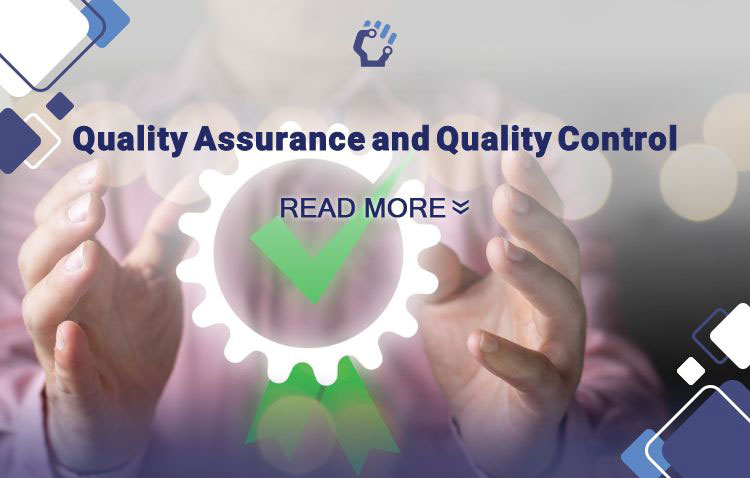Are you confused about the difference between Quality Assurance and Quality Control? Do you find it difficult to navigate through technical jargon and complex explanations?
In this blog post, we will break down the key differences between Quality Assurance and Quality Control in a way that is easy to understand and relatable.
Let's dive right in and explore the world of Quality Assurance and Quality Control.
According to recent studies, 43% of businesses struggle with implementing effective quality management processes, leading to a decrease in customer satisfaction and overall productivity. This alarming statistic highlights the importance of understanding the distinctions between Quality Assurance and Quality Control to ensure the success and growth of your business.
Quality assurance and quality control are often used interchangeably, but they are not the same thing. They are both essential for ensuring the quality of products or services, but they have different goals, methods, and outcomes.
In this article, we will provide you with a clear and concise explanation of the five key differences between Quality Assurance and Quality Control. By the end of this post, you will have a solid understanding of these concepts and be able to apply them to your own quality management practices.
So, without further ado, let's jump right into it!
Quality Assurance
Quality assurance is the process of ensuring that the quality requirements are defined and fulfilled. It is based on the principle of “doing things right the first time”.
The purpose of quality assurance is to:
-
Establish and maintain quality standards and procedures
-
Monitor and evaluate the performance and effectiveness of the processes
-
Identify and eliminate the root causes of quality problems
-
Improve the quality of the products or services continuously
-
Enhance customer satisfaction and loyalty
Some examples of quality assurance activities are:
-
Conducting quality audits and reviews
-
Providing quality training and coaching
-
Implementing quality management systems and tools
-
Applying quality improvement methods and techniques
-
Documenting and reporting quality issues and actions
Read more: What Is Software Quality Assurance, and Why Is It Important?

Quality Control
Quality control is the process of verifying that the quality requirements are met. It is based on the principle of “checking things after they are done.
The purpose of quality control is to:
-
Ensure that the products or services conform to the specifications and expectations
-
Detect and correct any defects or errors in the products or services
-
Prevent the delivery of faulty or substandard products or services
-
Reduce the costs and risks of quality failures
-
Maintain and improve the reputation and credibility of the organization
Some examples of quality control activities are:
-
Performing quality inspections and tests
-
Using quality control charts and graphs
-
Applying quality control standards and criteria
-
Implementing quality control tools and techniques
-
Documenting and reporting quality results and feedback
Read more: The Role of Software QA in Agile Development Methodologies

5 Key Differences between Quality Assurance & Quality Control
Quality assurance and quality control are two terms that are often used interchangeably, but they have distinct meanings and functions in the context of quality management.
Quality assurance and quality control are both essential for quality management, but they have some key differences.
Here are some of them:
1. Quality Assurance is Proactive, Quality Control is Reactive
One of the main differences between quality assurance and quality control is the timing of their activities. Quality assurance is a proactive process that aims to prevent defects or errors from occurring in the first place.
Quality assurance involves planning, designing, and implementing quality standards and procedures throughout the product or service development cycle. Quality assurance ensures that the product or service meets the customer’s expectations and requirements before it is delivered.
Quality control, on the other hand, is a reactive process that detects and corrects defects or errors after they have occurred. Quality control involves testing, inspecting, and reviewing the product or service after it is completed or delivered.
Quality control ensures that the product or service conforms to the quality standards and specifications that were set by quality assurance.
2. Quality Assurance is Process-Oriented, Quality Control is Product-Oriented
Another difference between quality assurance and quality control is the focus of their activities. Quality assurance is process-oriented, meaning that it focuses on improving the processes that are used to create the product or service.
Quality assurance evaluates and monitors the quality of the inputs, outputs, and activities that are involved in the product or service development cycle. Quality assurance aims to improve the efficiency, effectiveness, and consistency of the processes, and to prevent any deviations or variations from the quality standards and procedures.
Quality control is product-oriented, meaning that it focuses on verifying the quality of the product or service itself. Quality control measures and evaluates the quality of the final product or service against the quality standards and specifications that were set by quality assurance.
Quality control aims to identify and eliminate any defects or errors that may affect the performance, functionality, or reliability of the product or service.
3. Quality Assurance is done by the Whole Team, Quality Control is done by a Specific Team
Another difference between quality assurance and quality control is the responsibility of their activities.
Quality assurance is done by the whole team that is involved in the product or service development cycle, such as the project managers, developers, designers, and engineers.
Quality assurance requires the collaboration and coordination of the whole team to ensure that the quality standards and procedures are followed and implemented throughout the process. Quality assurance fosters a culture of quality within the team, and encourages continuous improvement and learning.
Quality control is done by a specific team that is dedicated to testing and inspecting the product or service, such as the quality control engineers, testers, or auditors. Quality control requires the expertise and skills of the quality control team to ensure that the product or service meets the quality standards and specifications that were set by quality assurance.
Quality control provides feedback and reports to the quality assurance team and the rest of the team, and suggests corrective actions and solutions.
4. Quality Assurance is a Preventive Measure, Quality Control is a Corrective Measure
Another difference between quality assurance and quality control is the outcome of their activities. Quality assurance is a preventive measure, meaning that it prevents defects or errors from occurring in the product or service.
Quality assurance reduces the risk of failure, rework, or customer dissatisfaction by ensuring that the product or service is designed and developed according to the quality standards and requirements. Quality assurance saves time, money, and resources by avoiding the need for quality control or repairs.
Quality control is a corrective measure, meaning that it corrects defects or errors that have occurred in the product or service. Quality control minimizes the impact of failure, rework, or customer dissatisfaction by ensuring that the product or service is fixed and improved according to the quality standards and specifications.
Quality control adds time, money, and resources by requiring quality control or repairs.
5. Quality Assurance is a Part of Quality Management, Quality Control is a Part of Quality Assurance
Another difference between quality assurance and quality control is the relationship of their activities. Quality assurance is a part of quality management, which is the overall system that guides and controls the quality of products or services.
Quality management includes quality planning, quality assurance, quality control, and quality improvement. Quality management ensures that the quality objectives and policies of the organization are aligned and achieved.
Quality control is a part of quality assurance, which is one of the components of quality management. Quality control is the last step of quality assurance, which is the first step of quality management.
Quality control verifies and validates the quality of the product or service that was assured by quality assurance, which was planned by quality management.
Ensure excellence in your products! Contact us for top-notch Quality Assurance services and elevate your standards today.

The Similarities between Quality Assurance and Quality Control
Despite these differences, quality assurance and quality control also have some similarities. They both:
-
Have the same goal of ensuring quality
-
Follow the same quality principles and guidelines
-
Use the same quality tools and techniques
-
Require the same quality skills and knowledge
-
Involve the same quality stakeholders and customers
How to Implement Quality Assurance and Quality Control in Your Business
Quality assurance and quality control are not mutually exclusive. They are complementary and interdependent. To implement quality assurance and quality control in your business, you need to:
-
Define your quality objectives and requirements. What are the expectations and standards of your customers and stakeholders? What are the regulations and norms of your industry and market?
-
Plan your quality processes and procedures. How will you design and execute your production or service delivery processes? How will you ensure that they meet the quality objectives and requirements?
-
Perform your quality activities and tasks. How will you monitor and measure the quality of your products or services? How will you identify and correct any quality issues or problems?
-
Evaluate your quality performance and results. How will you analyze and interpret the quality data and feedback? How will you assess and improve the quality of your products or services?
-
Communicate your quality information and actions. How will you document and report your quality activities and outcomes? How will you inform and involve your quality stakeholders and customers?
Why Quality Assurance and Quality Control Matter
Quality assurance and quality control are vital for quality management. They help you to:
-
Deliver high-quality products or services that meet or exceed the customer’s expectations and satisfaction
-
Comply with the standards and regulations of your industry and market
-
Reduce the costs and risks of quality failures and errors
-
Improve the efficiency and effectiveness of your processes and operations
-
Enhance the reputation and credibility of your organization and brand
By implementing quality assurance and quality control in your business, you can achieve a competitive edge and a sustainable growth. Quality is not only a requirement, but also an opportunity.
Conclusion
In conclusion, we have explored the key differences between Quality Assurance and Quality Control. Quality Assurance focuses on proactive measures to prevent defects and ensure a high standard throughout the entire process. On the other hand, Quality Control involves the inspection and testing of products to identify any defects or issues.
By understanding these distinctions, businesses can effectively implement both QA and QC strategies to deliver top-notch products and services to their customers.
Quality assurance and quality control are both important for ensuring the quality of products or services, but they are not the same thing. They have different goals, methods, outcomes, focuses, responsibilities, and relationships.
By understanding the differences between quality assurance and quality control, you can implement them effectively and efficiently in your business processes, and boost your business performance and customer satisfaction.
Thank you so much for taking the time to read this article. We hope it has shed some light on the differences between Quality Assurance and Quality Control.
If you have any questions or face any problems related to the topics discussed in this article, please feel free to reach out. We would be more than happy to assist you. Simply leave your queries in the comment section below, and we'll get back to you as soon as possible.
Frequently Asked Questions about Differences between Quality Assurance Quality Control
What is quality assurance?
Quality assurance is a proactive process that focuses on preventing defects and errors in products or services. It involves implementing systems and processes to ensure that the desired level of quality is consistently met.
What is quality control?
Quality control is a reactive process that focuses on identifying and correcting defects and errors in products or services. It involves inspecting and testing the final output to ensure that it meets the desired quality standards.
What is the main goal of quality assurance?
The main goal of quality assurance is to prevent defects and errors from occurring in the first place. It aims to establish and maintain processes that consistently deliver products or services of high quality.
What is the main goal of quality control?
The main goal of quality control is to identify defects and errors in the final output and take corrective actions to ensure that the desired quality standards are met. It focuses on inspecting and testing the product or service before it reaches the customer.
What is the difference between quality assurance and quality control?
Quality assurance and quality control are both important processes in ensuring the quality of a product or service, but they have different focuses.
Quality assurance is a proactive process that aims to prevent defects or issues from occurring in the first place. It involves establishing and implementing quality standards, conducting regular audits and inspections, and continuously improving processes.
On the other hand, quality control is a reactive process that focuses on identifying and fixing defects or issues after they have occurred. It involves testing and inspecting products or services to ensure they meet the established quality standards.
How do quality assurance and quality control work together?
Quality assurance and quality control work hand in hand to ensure the overall quality of a product or service. While quality assurance focuses on processes and prevention, quality control focuses on testing and correction. Quality assurance sets the standards and guidelines for a product or service, while quality control ensures that these standards are met.
By implementing a robust quality assurance program, organizations can reduce the likelihood of defects or issues, making the role of quality control more manageable. Together, they help to create a culture of quality and continuous improvement.








